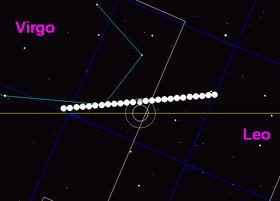
March 2006 lunar eclipse
Encyclopedia
| Penumbral lunar eclipse March 14, 2006 |
|
|---|---|
 0:54 UT from Warrenton, Virginia Warrenton, Virginia Warrenton is a town in Fauquier County, Virginia, United States. The population was 6,670 at the 2000 census, and 14,634 at the 2010 estimate. It is the county seat of Fauquier County. Public schools in the town include Fauquier High School, Warrenton Middle School, Taylor Middle School and two... (Penumbral shadow visible faintly on the right an hour past greatest eclipse) |
|
 The moon passed right to left through the Earth's north penumbral shadow. |
|
| Series (and member) Saros cycle The saros is a period of 223 synodic months , that can be used to predict eclipses of the Sun and Moon. One saros after an eclipse, the Sun, Earth, and Moon return to approximately the same relative geometry, and a nearly identical eclipse will occur, in what is referred to as an eclipse cycle... |
113 (63) |
| Duration (hr:mn:sc) | |
| Penumbral | 04:52:00 |
| Contacts | |
| P1 | 21:21:32 UTC |
| Greatest | 23:47:32 |
| P4 | 02:13:32 UTC |
 The moon's path across shadow in Virgo. |
|
A penumbral lunar eclipse
Lunar eclipse
A lunar eclipse occurs when the Moon passes behind the Earth so that the Earth blocks the Sun's rays from striking the Moon. This can occur only when the Sun, Earth, and Moon are aligned exactly, or very closely so, with the Earth in the middle. Hence, a lunar eclipse can only occur the night of a...
took place on March 14, 2006, the first of two lunar eclipses in 2006.
This was a relatively rare total penumbral lunar eclipse
Total penumbral lunar eclipse
A total penumbral eclipse is a lunar eclipse occurs when the moon becomes completely immersed in the penumbral cone of the Earth without touching the umbra....
with the moon passing entirely within the penumbral shadow without entering the darker umbral shadow.
Visibility
It was completely visible over Africa and Europe, seen rising over eastern North America, all of South America, and setting over western Asia.
A simulated view of the earth from the center of the moon at maximum eclipse.
Saros series
The eclipse belongs to Saros seriesSaros cycle
The saros is a period of 223 synodic months , that can be used to predict eclipses of the Sun and Moon. One saros after an eclipse, the Sun, Earth, and Moon return to approximately the same relative geometry, and a nearly identical eclipse will occur, in what is referred to as an eclipse cycle...
138, and is the 29th of 83 lunar eclipses in the series. The first penumbral eclipse of saros cycle 138 began on October 5, 1503, first partial eclipse on June 13, 1900, and total first will be on September 7, 2044. The last total eclipse will occur on June 8, 2495, last partial on August 13, 2603, and last penumbral eclipse on March 30, 2982.
See also
- List of lunar eclipses and List of 21st century lunar eclipses
- May 2003 lunar eclipseMay 2003 lunar eclipseA total lunar eclipse took place on May 16, 2003, the first of two total lunar eclipses in 2003, the other being on November 9, 2003.- Saros series :It is a member of Saros cycle 121.- Lunar year series :...
- November 2003 lunar eclipseNovember 2003 lunar eclipseA total lunar eclipse took place on November 9, 2003, the second of two total lunar eclipses in 2003, the first being on May 16, 2003.-Photo gallery:-Lunar year series:It is the second of four lunar year cycles, repeating every 354 days....
- May 2004 lunar eclipseMay 2004 lunar eclipseA total lunar eclipse took place on May 4, 2004, the first of two total lunar eclipses in 2004, the second being on October 28, 2004.- Visibility :...
- :File:2006-03-14 Lunar Eclipse Sketch.gif Chart

